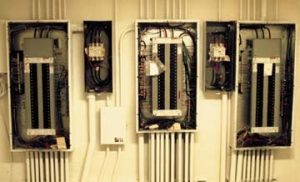Metal Fabrication
Grounded in Reality
Understanding simple components of the electrical trade resolves many installation problems
Published
18 years agoon

Beginning a new column in a different magazine represents a new chapter in my life. I’ve met new colleagues and formed new friendships, which is a rewarding experience.
Also, I’ve created a new column name. I wanted to include the word "ground" within the title, because this column deals with electrical aspects of signs. Ground, or rather, its nonexistence, causes the majority of field failures for the new generation of transformers.
Because some electric-sign installations have caused fires, our industry was mandated to mechanically police its power supplies with "Secondary-Circuit Ground-Fault Protection" via the National Electrical Code (NEC®), Section 600.23; the Canadian Electrical Code (CEC), Section 34-300; UL 2161; and, in the near future, CSA standard C22.2 #255 sensing devices.
I’ve crafted this column to help you understand the idiosyncrasies of the electric-sign profession. I’ll address those singularities, along with standard electrical practices, and explain them in simple terms.
There’s so much to learn and share regarding the electric-sign profession. Ideally, this column serves as part of your apprenticeship, as well as advanced electrical-sign training grounds. Whether you’re entering the sign field or attempting to move forward into more advanced methodology, I’m dedicated to providing you with the best and latest information the industry offers. $image1
Down to the "wire"
AdvertisementThe recent Sign Expo 2002 show in Orlando, sponsored by the International Sign Assn., included key seminars on the 2002 NEC and UL 2161.
The NEC seminar allotted some time to Table 310.16 (wire ampacities). In the UL 2161 seminar, attendees wanted to discuss voltage on the neutral leg of a primary branch circuit. Meanwhile, on the hot seats in front, various transformer manufacturers defended their products and professed to solve a "primary" (incoming-circuit) problem.
Most sign circuits involve three types of "conductor" wires, or wires that serve as energy carriers. Approximately 80% of basic sign circuits feature black, white and green wires (Fig. 1). Future columns will deal with other color codes, but for simplicity, I’ll deal with only the very basic 120V, dedicated equipment, which controls no equipment other than signs.
All aboard
The black conductor wire, or the hot conductor, carries incoming voltage and current from the panel board. The NEC refers to it as the "ungrounded or phase conductor." During Edison’s time, an electric company sent power from its hydro- or coal-fired plants to homes via what are now black wires, the only conductors at the time.
The power conducted along black wires is often referred to as 110V or 115V, the designated voltages during the ’20s through ’60s. Presently, all equipment and services in North America are designed on a 120V platform. Current transformers not only need 120V to operate, but the voltage must be "clean." The NEC disallows any other "draw," or load, attached to a sign circuit (see Section 600.5(A) of the NEC).
AdvertisementCalled the "common" or "identified" conductor for years, the white conductor wire, the "neutral" or "grounded" conductor, is the return conductor that completes the circuit. After all, what goes out, must come back. Without this conductor, the circuit doesn’t operate.
This second conductor was added as a safety precaution to prevent electrical fires. Otherwise, if compromised, the black (hot) conductor, which carried all the power, had no safe place to dump its volatile cargo.
Normally, the white, grounded/neutral (these terms are interchangeable) conductor carries an unbalanced load. Note that these principles don’t hold true for fluorescent/neon (non-linear lighting loads) or 277V circuits.
Think of a black conductor as a truck carrying loads of power/coal, to transformers/neon tubes to provide energy for light. The white grounded conductor allows the truck to return to the panel box with its hopper mostly empty. This neutral conductor then carries the return current back to the source.
Here, we must address the common electrical-trade practice of sharing a neutral (a white grounded conductor), which the NEC calls "multi-wire branch circuits," as indicated in 210.4(A), and the definition of a multiwire branch circuit in Article 100.
In most circumstances, an electrician saves considerable conduit space (and material cost) by pulling multiple hot conductors and using one common neutral to act as the grounded conductor that services its multi-wire branch circuits.
AdvertisementHowever, this "shared" grounded conductor is no longer "clean," or dedicated to an individual circuit (hot) conductor. Grounded sharing can, and has, caused problems, especially with the new NEC 600.23, UL 2161-compliant transformers. The new generation of transformer incorporates the grounded conductor in its sensing scheme. If restaurant refrigeration units or other large motors share the grounded conductors, power supplies can experience nuisance tripping due to the inrush of currents as other loads cycle on and off. As sign professionals, we must understand these problems, as well as the demands we must make on our clients and general electrical contractors at each site. Consequently, initial site contacts and surveys must show what conductors we need and the requisite conditions for a proper installation. $image2
In the main panel box, the white grounded conductor wire originates from the neutral bus, a silvery, typically long, metal bar on which several set screws run vertically on either side of the hot breaker banks.
The green conductor wire serves as the grounding conductor. As grounded systems and service were developed, the green conductor provided additional safety precautions by minimizing voltage spikes during lighting strikes or line surges. Proper grounding allows breakers or fuses (over-current devices) to operate more quickly when responding to ground faults. This safety-circuit conductor only operates in emergency conditions. Using the truck analogy, in an electrical accident, trucks with volatile cargo are routed off to the runaway truck ramp, or the green/grounding conductor.
For electricians, the conceptual difference between grounded and grounding remains an enigma. A friend from Connecticut explained that grounded refers to a white grounded conductor, while grounding denotes ongoing conditions. Thus, the green grounding conductor remains the final safety conductor.
The real world
At Carolina Sign Group/Vermont Sign (Black Mountain, NC/Essex Junction, VT), we’ve installed many remote neon signs since our inception in ’73. In ’79, we mandated that all installations that included transformers over 7,500V be midpoint wired.
When the NEC 600.23, UL 2161-compliant transformers first emerged, we completed an installation using the first prototypes from all the major power-supply manufacturers. This was before these next-generation units surfaced. We experienced "nuisance tripping" — only once.
We were installing ruby-red neon, exposed, interior, metal channel letters with remote transformers at the Asheville (NC) Mall. We had midpoint wired all of our secondary home runs and multi-metered their loadings. When we energized the display, everything lit.
Approximately a half-hour later, all the transformers tripped. We thoroughly troubleshot the display and found the install to be clean. Again, we energized the display, and, this time, everything stayed lit for approximately three hours. Then, blam, the whole display tripped.
We’d never previously received a bad ground-fault transformer, but we thought that maybe this was the first time. Still, this didn’t account for four sections failing at once. The problem had to be somewhere between our lockable sign-service disconnect and the main panel.
And it was. The electric company wired the restaurant’s refrigeration units on the same white grounded conductor as our sign. Every time the refrigerator motors had an inrush, the sensors tripped.
Who was at fault? The electrical contractor hadn’t followed code, and, as a result, we had to pull a separate dedicated circuit for our display. Problem solved.
SPONSORED VIDEO
Introducing the Sign Industry Podcast
The Sign Industry Podcast is a platform for every sign person out there — from the old-timers who bent neon and hand-lettered boats to those venturing into new technologies — we want to get their stories out for everyone to hear. Come join us and listen to stories, learn tricks or techniques, and get insights of what’s to come. We are the world’s second oldest profession. The folks who started the world’s oldest profession needed a sign.
You may like
Advertisement
Subscribe

Magazine
Get the most important news
and business ideas from Signsofthetimes Magazine.
Advertisement
Most Popular
-

 Tip Sheet3 days ago
Tip Sheet3 days agoAlways Brand Yourself and Wear Fewer Hats — Two of April’s Sign Tips
-

 Business Management1 week ago
Business Management1 week agoWhen Should Sign Companies Hire Salespeople or Fire Customers?
-

 Women in Signs2 weeks ago
Women in Signs2 weeks ago2024 Women in Signs Award Winners Excel in Diverse Roles
-

 Real Deal4 days ago
Real Deal4 days agoA Woman Sign Company Owner Confronts a Sexist Wholesaler
-

 Editor's Note1 week ago
Editor's Note1 week agoWhy We Still Need the Women in Signs Award
-

 Line Time2 weeks ago
Line Time2 weeks agoOne Less Thing to Do for Sign Customers
-

 Product Buying + Technology1 week ago
Product Buying + Technology1 week agoADA Signs and More Uses for Engraving Machines
-

 Women in Signs4 days ago
Women in Signs4 days ago2024 Women in Signs: Megan Bradley











